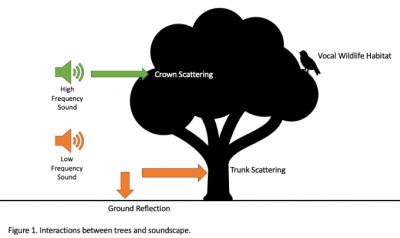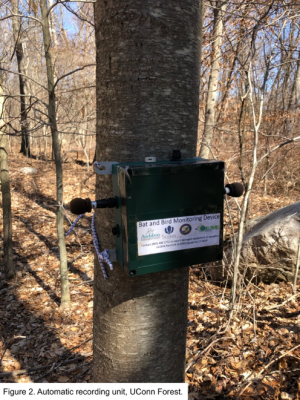What is a soundscape?
When recalling an enjoyable walk in nature, what do you think of? The trees, the sunshine, flowers, a lakeside view? Or perhaps you think of birds singing, leaves rustling in the wind, a babbling brook, or a peaceful quiet? When studying landscapes and their quality as a habitat or a recreational space, we have historically focused on visual attributes, but increasingly scientists and park managers are recognizing the value of soundscape, the collection of sounds present in a landscape.
Unwanted sound, or noise, has long been studied as a pollutant and regulated for its harmful health impacts such as hearing loss and increased stress. Noise also impacts wildlife, often masking animal communication that is important for attracting mates, detecting predators, and more.
Noise reduction, while important, is only a fraction of the story soundscapes can tell us. According to past studies, the entire range of sounds we hear affects our perception of nature, our experience enjoying parks, and our sense of place. The diversity of sounds within a soundscape is also a useful indicator of biodiversity, because it indicates the presence of many different sound-producing animals such as birds, insects, and amphibians.
For these reasons, diverse soundscapes are increasingly being recognized as valuable natural resources.
Trees and Sound

Soundscape is directly impacted by landscape features such as topography, development, and even vegetation. In a forest, trees contribute to noise attenuation, allowing for a quieter interior than would be achieved with distance alone. A tree’s foliage and crown scatters high frequency sound, while the trunks reflect, absorb, and scatter low frequency sound. This latter effect has been particularly valuable in urban areas, where tree belts are sometimes implemented as noise barriers. A forest’s soft, porous soil also contributes to noise attenuation by reflecting low frequency noise.
In addition to their physical interactions with sound, trees also affect soundscape by providing habitat for vocalizing wildlife. The same characteristics that improve habitat quality in a forest will also harbor a more diverse natural soundscape.
How does this relate to Stormwise?

Stormwise aims to protect utility infrastructure while providing for a healthy, functioning roadside forest ecosystem. Noise attenuation, recreational value, and wildlife habitat provision are three important ecosystem functions that can all be studied with acoustic monitoring, the use of automated audio recorders to collect data on soundscape. These functions are particularly important along roadsides, where traffic noise is particularly high and biodiversity is already being impacted by forest fragmentation.
We are developing a study that will use acoustic monitoring tools to compare the soundscape of Stormwise sites, control sites, and other forest edge types in an effort to understand how forest edge structure relates to the acoustic environment. This will have implications for the potential benefits or costs of forest management, from the perspective of both human experience and biodiversity conservation.